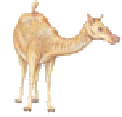Geology Reference
In-Depth Information
Deer
Camel
Whale
Sea cow
Elephant
Hyrax
Horse
◗
Figure 18.8
Divergent Evolution Divergent
evolution of several types of placental mammals
from a common ancestor. Divergence accounts for
descendents that differ from their ancestors and
from one another.
Common
ancestor
Micro
and
macro
are prefixes that mean “small” and “large,”
so
microevolution
is any change in the genetic makeup of a
species. For example, house sparrows were introduced into
North America in 1852 and have evolved so that members
mammals elsewhere—for example, catlike marsupial
carnivores and true cats. Parallel evolution, in contrast,
involves closely related organisms, such as jerboas and
kangaroo rats, that independently evolved comparable fea-
tures (Figure 18.9b).
◗
North America
South America
Figure 18.9
Convergent and Parallel Evolution
Saber-toothed cat
Marsupial carnivore
Early
camel
Camel-like
litoptern
Early
rhinoceros
Toxodon
Kangaroo rat
Jerboa
Similiar features
develop
Convergence
Divergence
Distantly related ancestors
Common ancestor
Parallel evolution involves the
independent origin of similar features
in closely related organisms.
Convergent evolution takes place when distantly related organisms
give rise to species that resemble one another because they adapt in
comparable ways.
a
b









































































Search WWH ::

Custom Search